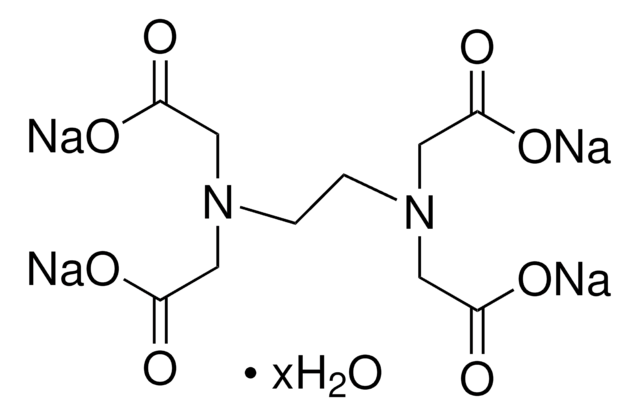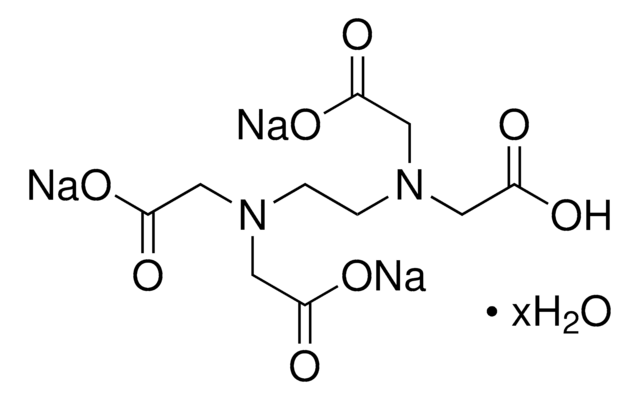ED4SS
Ethylenediaminetetraacetic acid tetrasodium salt dihydrate
99.0-102.0% (titration)
Synonym(s):
EDTA tetrasodium salt, Edathamil, Tetrasodium ethylenediaminetetraacetate dihydrate
About This Item
Recommended Products
Quality Level
Assay
99.0-102.0% (titration)
form
crystalline
reaction suitability
reagent type: chelator
solubility
H2O: soluble, clear, colorless
SMILES string
O.O.[Na+].[Na+].[Na+].[Na+].[O-]C(=O)CN(CCN(CC([O-])=O)CC([O-])=O)CC([O-])=O
InChI
1S/C10H16N2O8.4Na.2H2O/c13-7(14)3-11(4-8(15)16)1-2-12(5-9(17)18)6-10(19)20;;;;;;/h1-6H2,(H,13,14)(H,15,16)(H,17,18)(H,19,20);;;;;2*1H2/q;4*+1;;/p-4
InChI key
KSYNLCYTMRMCGG-UHFFFAOYSA-J
Looking for similar products? Visit Product Comparison Guide
General description
Application
- in the decalcification of femurs for the histoprocessing and staining of osteochondral tissue
- as a component of NH4Cl lysis buffer for erythrocyte lysis and bulk characterization
- for the isolation of crypts from the connective tissues of mice
Biochem/physiol Actions
Signal Word
Danger
Hazard Statements
Precautionary Statements
Hazard Classifications
Acute Tox. 4 Inhalation - Acute Tox. 4 Oral - Eye Dam. 1 - STOT RE 2
Target Organs
Respiratory Tract
Storage Class Code
11 - Combustible Solids
WGK
WGK 2
Flash Point(F)
Not applicable
Flash Point(C)
Not applicable
Personal Protective Equipment
Certificates of Analysis (COA)
Search for Certificates of Analysis (COA) by entering the products Lot/Batch Number. Lot and Batch Numbers can be found on a product’s label following the words ‘Lot’ or ‘Batch’.
Already Own This Product?
Find documentation for the products that you have recently purchased in the Document Library.
Customers Also Viewed
Articles
Enzymatic Assay of Cathepsin B
Protocols
Recycling Micro-Assay of β-NAD and β-NADH
Enzymatic Assay of α-Glucosidase by the Modified Boehenger Procedure (EC 3.2.1.20)
Enzymatic assay of lipase type XIII from Pseudomonas sp. using a coupled enzyme system of glycerol kinase and glycerophosphate oxidase (EC 3.1.1.3)
This procedure may be used for all Ficin products.
Our team of scientists has experience in all areas of research including Life Science, Material Science, Chemical Synthesis, Chromatography, Analytical and many others.
Contact Technical Service









